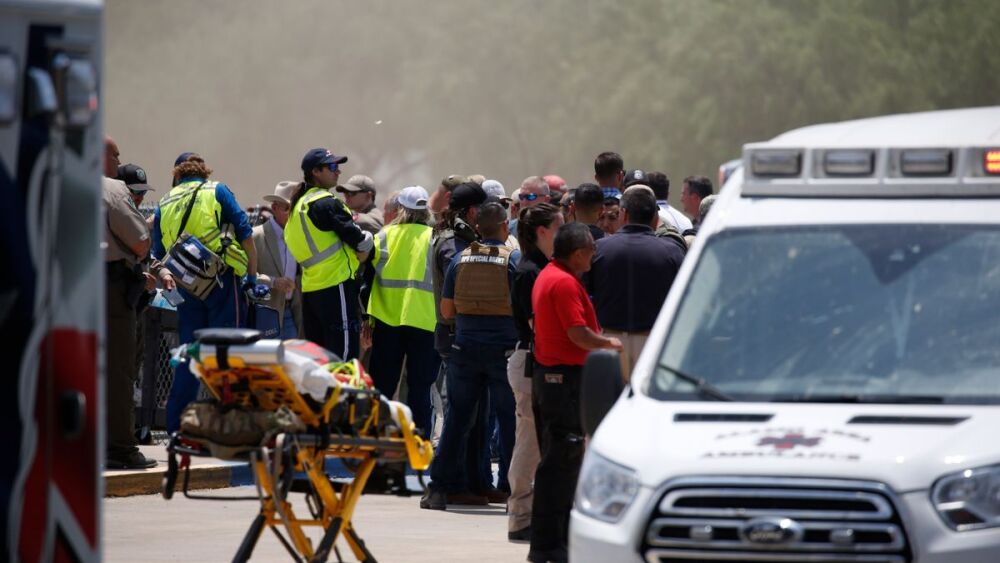Our thoughts are with the families and the first responders impacted by the tragic shooting at Robb Elementary School in Uvalde, Texas. Learn more about this response and supporting members’ mental health in times of crisis with these incident analyses:
- In “Uvalde shooting: Echoes of Sandy Hook for responders and parents,” Greg Friese, MS, NRP, offers gratitude for the teachers, police officers, EMTs, paramedics, hospital personnel, pilots and other helpers who aided injured children, and looks to what comes next.
- In “Uvalde aftermath: What should we do today?” Rob Lawrence encourages EMS leaders to take steps now to protect members from future tragedy, writing, “Sadly, this isn’t the last time we will see these headlines, but for us, today, put the tourniquet away and focus on the heart and soul of those in our charge.”
As I read the information surrounding the tragic events yesterday in Uvalde, Texas, I am reminded how important it is to be really good at the basics.
What happened: Nineteen children and 2 adults were killed when a shooter opened fire at Robb Elementary school.
There are two phases to consider in a MCI such as this:
- Left of bang – before the incident has occurred – where we do our preparatory work; we train, we equip, we implement policies and conduct joint training exercises
- Right of bang – after the incident has occurred – where we have to put those policies and practices into place.
Top takeaways from the Uvalde school shooting
Now, in the post-incident phase for Uvalde Texas, here are 5 takeaways for consideration.
1. Train with police to begin lifesaving measures ASAP
Unfortunately, we still have to wait for some level of provider safety to go in and start treating patients. However, if we train together with our law enforcement partners, they can have the ability – once they have mitigated the threat – to immediately start lifesaving measures, such as tourniquet applications, chest seals, placing people in the recovery position, etc.
2. Rapid triage is the first order of business
When EMS resources are able to make entry to an MCI scene, the most important thing is effective, speedy evaluation of patients and fixing what is going to kill them right here right now. In general, that comes down to recognizing and identifying the four identified potentially preventable causes of death from traumatic injury:
- External hemorrhage
- Airway obstruction
- Respiratory compromise
- Hypothermia
With those four in mind, rapid triage for these injuries is the first order of business. In general, we really only consider patients to fall into one of two categories in these direct or indirect threat environments: They are red or they are dead. There is no time for the subtleties and nuance of traditional triage.
3. Be good at the basics
We need to have our kits assembled and ready to deal with multiple patients on that basic lifesaving level. It’s really critical to be really good at the basics. We need to be experts at tourniquets. We need to be experts at chest seals and the rapid recognition of symptomology and physical presentation of these types of injuries.
4. Have the right tools
Many departments have instituted rescue task force type capabilities to get help in to victims faster, but all that’s for not if you don’t have the equipment that you need to treat the people who are suffering from these types of traumatic injuries.
This means having multiples of basic interventions like tourniquets, chest seals and wound packing materials.
5. Have and communicate a plan for exfiltrating the wounded
The other really big considerations are how are you going to move the injured? Sounds simple: Get in, treat them and move them out. The reality: Moving people is hard. It’s usually given lip service when planning, but really needs to be thought out and planned for.
- What are you going to move them with? Carrying someone, even a small person, is laborious and inefficient.
- Where are you going to take them? Is there a casualty collection point? Is there a route that has been locked down by law enforcement to freely move back and forth?
- Have you communicated and coordinated with command which exit you will use to come out of the building? Popping unannounced from a door or a window during an active violence situation is the last thing you want to do, and it may get you shot.
The exfiltration of wounded should be the first thing that you consider before crossing the threshold of the target building. Make sure you have a plan; you have the equipment and manpower to enact that plan; and that the plan has been communicated and agreed upon with all members of the entry team and command before making entry.
With good training and exercise programs, these plans can be set up and implemented very quickly.
What happens next: Forewarned is forearmed! If you still think this could never happen in your community, I am not sure what to tell you. Train, practice, communicate, treat. These are our mandates.
Learn more about MCI preparedness
Be prepared for a mass casualty incident with these resources:
- Committee for Tactical Emergency Casualty Care
- DHS: Active shooter preparedness
- First Care Provider
- On-Demand: When seconds count – Stop the bleed
- The key to saving more lives in a mass violence incident
- Training hard and fighting easy
- How to avoid the most common active shooter training mistakes
- Training day: Disaster response, transporting patients from the scene
- How to practice the EMS response to an MCI



